This is a "push" theory of gravity (rather than a "pull" theory), and that has known problems.
You should note that the existence of dark energy is deduced indirectly from motion of celestial bodies under the assumption that the standard general-relativistic theory of gravity holds. Also, and this is a more general point, educated specialists in any field - not only physics - aren't stupid and really know their field. Therefore, if you, as a non-physicist, can come up with a simple theory of gravity that is not believed by the physicists, the theory is almost certainly false - somebody certainly had the same idea long ago and there were reasons to reject it. Keeping this in mind can save you a lot of time and futile effort.
For reasons why your theory is false please follow the link in Mitchell Porter's comment.
Is this consistent with the fact that my father can demonstrate the gravitational attraction between two lead spheres in our basement?
Also, general relativity has consequences that are relevant to GPS satellites.
Anyway, you'd need equations for any of this to be really meaningful. I suspect that, if you tried to model this mathematically, you'd end up with something that basically matches Newtonian gravity.
EDIT: It turns out it doesn't, to the detriment of a theory of this kind.
I'm thinking no one object within a galaxy is emitting more dark energy than it shields its neighbors from. There is some galaxy-to-galaxy shielding, but it is very weak due to the amount of dark energy that can pass right through without hitting anything.
Which would imply that, on net, two galaxies would tend to attract each other, even if only weakly, because they do shield at least somewhat. I don't think this actually gets anywhere, other than simply pasting something akin to Newtonian gravity on top of an all-pervading repulsive force, such as Einstein's cosmological constant - which is what we already have.
Anyway, if it disagrees with Einstein, it's probably wrong, and if it agrees, then who cares?
I suspect that, if you tried to model this mathematically, you'd end up with something that basically matches Newtonian gravity.
I suspect that it wouldn't. His theory implies, among other things, that soft objects are flattened in the direction of the gravitational force (because it pushes only on the distant surface), that gravitational force in greater distance is proportional to 1/r (not squared), that a heavy object of mass M hidden behind the Sun would exert no additional pull on us (or, if the Sun is partly permeable to "dark energy", the difference in g would be still smaller than GM/r^2 as predicted by Newton)...
It may not be so important, but in my opinion we shouldn't so readily assume that a randomly made hypothesis is only a non-Occamian reformulation of the best available theory. Most random hypotheses are false.
Yes. Why would scaling it down more than I did make it disappear?
The only predictive difference I can think of is that with this model there would be regions in the universe where greater dark energy flow would result in a greater gravitational constant.
I would want to be more confident that it was meaningful before taking on a whole other branch of science at a professional level. And if I was already approaching it on that level, I would take it to a physics journal and not a blog.
I think there is some suggestion that this would be more appropriate on a physics blog and not a rationality blog.
The ability to tell apart a crackpot physical theory from a sensible one, at least on this visible level of crackpottery, does need very little specialised knowledge of physics and definitely is a rationalist skill.
So you would like people to post crackpot theories so that we can practice on them? I was trying to help by pointing out that there is a step between "physics journal" and nothing physics related. Perhaps I should have held my tongue and moved on with Mitchell_Porter and shminux 's comments being sufficient.
I wouldn't like people to post crackpot theories here so that we can practice on them. Also, I wouldn't like people to post crackpot theories on a physics blog so that somebody else could practice on them. But I would definitely like people have the freedom to explain, once the crackpot theory is posted, why it is wrong and how can we tell. The explanation can be useful for the author of the crackpot theory who may not be himself an incorrigible crackpot, and I believe we can explain the problem better than a physics blog audience, because typically believing in a crackpot theory isn't mainly a failure of the author's mastery of physics, but rather a problem with his general rationality skills.
In short, I don't say that this post is a net positive, I say it is not off-topic here.
Many of the refutations offered didn't actually contradict what I had in mind at all. For instance, I could come up with a (wrong) theory vaguely similar to general relativity, and showing how that's wrong =/= showing general relativity is wrong, similarly, the link about La Sage's theory is not some iron-clad refutation of this one.
However, I wasn't exactly confident that it was right; it actually bothered me that I couldn't come up with why I was wrong. I was mostly expecting to find out why my idea was wrong by running it by others who might already know more than me on the subject. I did wind up getting that (gravitational lensing clearly tears it apart). You guys certainly saved me the effort, either way, which freed me up to focus on actual useful efforts. This sort of effect is actually why I posted here before putting in all that work on something I strongly suspected would be a waste of time.
The main reason I'm commenting here again, is because of the total lack of civility of some of the replies. The negative karma score is probably what the post deserves, and I probably shouldn't expect anything else posting so far from my own specializations. However, there is a certain sting that comes with being wrong, and it's not that difficult to avoid adding to it when pointing out someone's errors. Sadly, the best example of being as rude as possible about it is actually the post that included what I was looking for.
Compare the difference between:
Have you considered gravitational lensing, or gravitational time dilation? Your theory seems to be incompatible with these observable and well-documented phenomena.
and:
Good start. I know how tempting it is to talk about crackpot physical theories, believe you me I do, but you've gotta contain yourself. Seriously, you're embarrassing me, and I'm not even you.
Since you failed #37, among others, I'll help you out. Your theory predicts that what we call gravity depends not on mass but on something like solid angle, which is a measure of how big one object appears from another. If we're talkin bout heaven here objects are spherical, so solid angle (and thus your theoretical force) depends only on the size of the object (radius) and distance. Guess what? It turns out that gravity actually depends on something called mass and energy. Newtonian gravity is linear in mass, but your theory is not (you can work out the relationship between proton count and surface area of a nucleus or something along those lines, tee hee). This linearity has been experimentally verified.
Anyway, does your theory have anything to say about this or this? Nope! It turns out gravity isn't as simple as pushing and pulling. Time and energy and fahoosalah are involved too. You might know about these things if you take physics courses.
LessWrong is partly about learning how to be wrong. You're wrong. LessWrong teaches to acknowledge when you don't understand something, to listen to the knowledge of those who do, and to not post silly crackpot theories that don't even. 0/10 will not think about again.
I’m not a physicist and it could be obviously wrong for some reason I’m missing
Good start. I know how tempting it is to talk about crackpot physical theories, believe you me I do, but you've gotta contain yourself. Seriously, you're embarrassing me, and I'm not even you.
Since you failed #37, among others, I'll help you out. Your theory predicts that what we call gravity depends not on mass but on something like solid angle, which is a measure of how big one object appears from another. If we're talkin bout heaven here objects are spherical, so solid angle (and thus your theoretical force) depends only on the size of the object (radius) and distance. Guess what? It turns out that gravity actually depends on something called mass and energy. Newtonian gravity is linear in mass, but your theory is not (you can work out the relationship between proton count and surface area of a nucleus or something along those lines, tee hee). This linearity has been experimentally verified.
Anyway, does your theory have anything to say about this or this? Nope! It turns out gravity isn't as simple as pushing and pulling. Time and energy and fahoosalah are involved too. You might know about these things if you take physics courses.
LessWrong is partly about learning how to be wrong. You're wrong. LessWrong teaches to acknowledge when you don't understand something, to listen to the knowledge of those who do, and to not post silly crackpot theories that don't even. 0/10 will not think about again.
I don’t know where else to go with this idea. I’m not a physicist and it could be obviously wrong for some reason I’m missing, but it seems to me that there is a small chance that I’ve figured out how to remove one of the fundamental forces from our models of the universe; gravity, to be specific.
So we’ve all heard of dark energy, the force driving the accelerating expansion of the universe. Presumably it comes from somewhere, perhaps from every piece of matter in the universe, perhaps only stars, perhaps only black holes, but as long as it’s not all coming from a single source, it’s probably coming from something that is relatively common, and primarily found within galaxies. And if I magically came to KNOW that it does all come from one source, I would do very little beyond deleting a few arrows in my diagrams to change this post.
And as the Hubble deep field scans showed, there are A LOT of galaxies in any direction you look in (at least from Earth). So, countless galaxies in all directions are emitting dark matter, with tiny rays from each one hitting our galaxy, as well as galaxies in every other direction.
Of course our galaxy doesn’t have a plastic shell around it for dark energy to hit. It’s specific things in the galaxy that get hit by specific emissions of dark energy, just like it’s specific objects that emit those emissions.
Here are some galaxies. Beyond the ones shown, there are more and more in all directions for as far as anyone knows so far. Please note that nothing in any of these diagrams is drawn to scale.
Any one of them emits dark energy pretty uniformly in all directions, as it does with light.
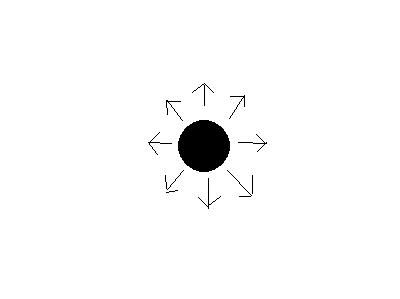
Given the sheer number of other galaxies off in all directions, the total dark energy hitting a galaxy would look something like this. The magnitude of the dark energy forces coming in from the rest of the universe ought to be a lot more than what our one little galaxy puts out.
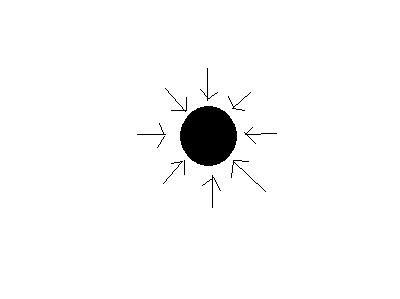
Now let’s look inside this galaxy, at a single solar system. Dark energy converges from all directions, as at the perimeter of the galaxy, since the galaxy is mostly empty space, and (I’m presuming) a more or less negligible amount is added from other objects within the galaxy.
Now let’s consider a single planet within the solar system
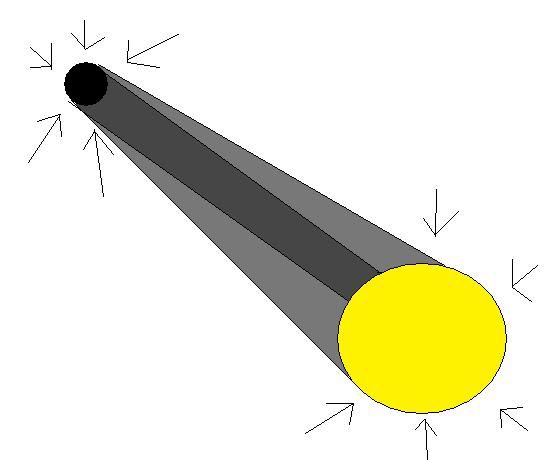
The sun casts a shadow in the dark energy field; some of the dark energy headed in the direction of our planet strikes the sun along the way and never makes it to the planet. To a lesser extent, the planet shields the sun as well. As the planet revolves around the sun, there is always a void in the otherwise all-pervasive dark energy field in the direction of the sun. As rudimentary as these diagrams are, you might as well just rotate your monitor if you really need a visual (keeping the screen on the same plane).
Each dark energy vector has an equal opposite cancelling it out, except in the shadow. Any other imbalance would be the same for the planet as it is for the star, and therefore would not alter their positions relative to each other. Even if it was all coming from one direction.
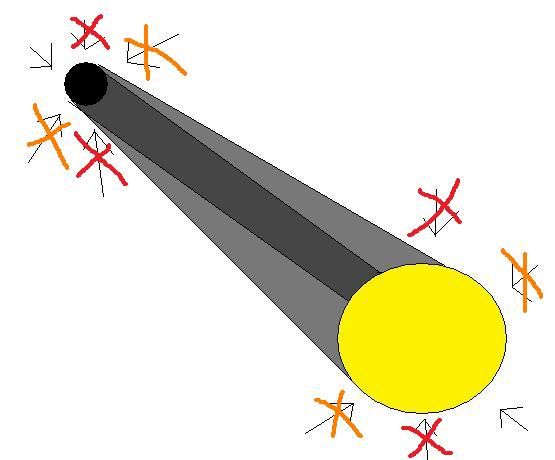
The planet always has one region that is only hit with the sun’s own dark energy emissions (if it has any), whereas all other sides are being hit with dark energy from all of the rest of the universe (in that direction), hence the illusion of gravity.
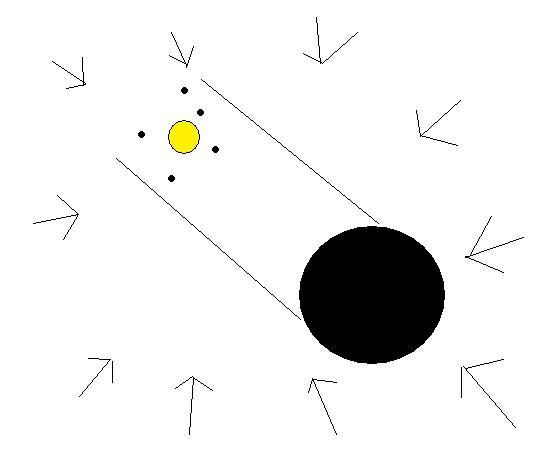
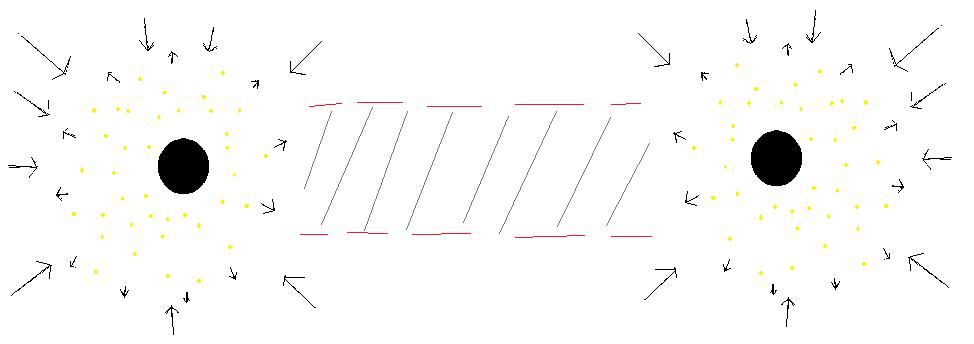
Similarly, a supermassive black hole at the center of a galaxy would cast a dark energy shadow on everything else in the galaxy, so the net push of all the dark energy vectors hitting a given star is toward the center of the galaxy, keeping it in orbit. This would be true of any given moment; the direction of the greatest push rotates around, but it is always toward the black hole.
The planets around the star are shielded by the black hole roughly the same amount as the star is, but they are much more strongly affected by the shielding from the star than the black hole is.
Now, consider 2 galaxies:
Each emits a little bit of dark energy of its own, and is mostly empty space so that much of the dark energy from other galaxies beyond it passes right through. I'm thinking no one object within a galaxy is emitting more dark energy than it shields its neighbors from. There is some galaxy-to-galaxy shielding, but it is very weak due to the amount of dark energy that can pass right through without hitting anything. This would be consistent with the galaxies spreading out from each other without being ripped apart by the force causing them to spread. So, between galaxies, there is a repulsive effect, while within galaxies, there is primarily an effect of shielding from the all-pervasive repulsion from dark energy.